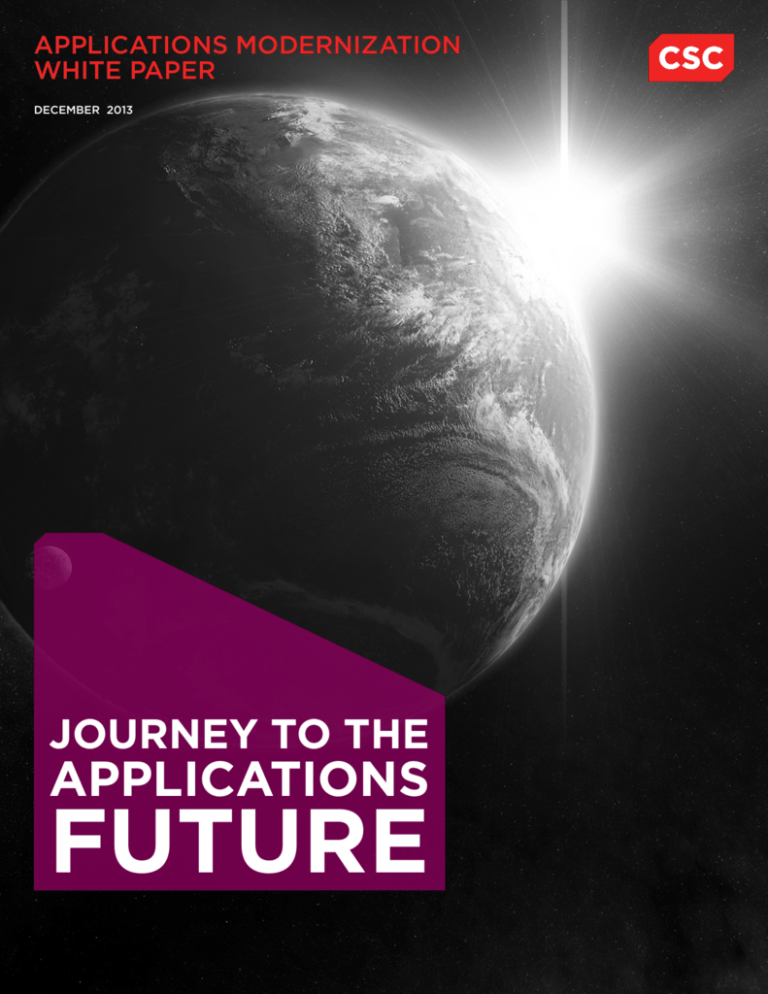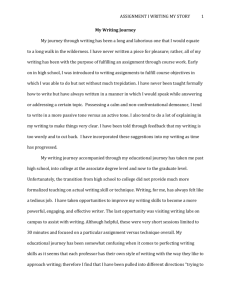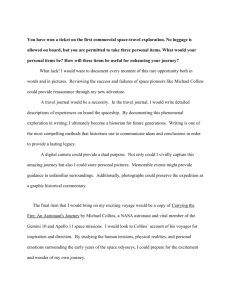
APPLICATIONS MODERNIZATION
WHITE PAPER
DECEMBER 2013
JOURNEY TO THE
APPLICATIONS
FUTURE
JOURNEY TO THE
APPLICATIONS FUTURE
CIOs need to embark on
a journey to rationalize,
modernize and transform
their enterprise
application portfolios
New and disruptive technologies dramatically improve
competitiveness and broaden access to timely information
New technologies offer the promise of a truly dynamic IT environment, one in which the
business enjoys major new benefits and much-improved operational efficiencies, and where
the role of the CIO evolves from that of managing “plan, build and run” functions to one of
orchestrating business and IT services. Unfortunately, many CIOs are in no position to realize
this valuable new opportunity. Instead, they are burdened by oversized, complex and costly
legacy application portfolios. As a result, for these CIOs, the opportunities promised by this
new world of IT services remain tantalizingly out of reach. At the same time, the gap between
what the business needs and expects, and what its IT group can deliver, continues to grow wider.
To bridge this gap, CIOs need to embark on a journey to rationalize, modernize and transform
their enterprise application portfolios. This journey begins with an assessment of the rationalization
options and treatments, moves on to migrating and modernizing legacy applications that must
be retained, and then transforms the application landscape and the value the portfolio delivers
to the business. For each step along this journey, CSC offers a unique mix of domain expertise,
IT talent and delivery capabilities that help our clients innovate and differentiate their business.
A DYNAMIC VISION FOR THE FUTURE APPLICATION PORTFOLIO
New and disruptive technologies offer CIOs the opportunity to develop an environment in
which the business enjoys far greater reach, much faster time to market, dramatically improved
competitiveness and broadened access to timely information.
Enabled by cloud computing, mobility, social media and big data analytics — what Gartner
calls the Nexus of Forces — IT is transforming user behavior and creating new business
opportunities. Nexus technologies can be used to create innovative products and services
that reach customers in new contexts. For example, mobile tablet devices have been used by
online vendors, telecommunications providers and IT suppliers to greatly extend the reach of
their businesses. Social media has transformed the way consumer brands interact with their
customers with context, and in real time. And big data is giving vendors new insights into
how their products are being used and can be improved.
Cloud computing in particular offers CIOs several major benefits:
•New, previously unimaginable levels of flexibility are now possible, thanks to the highly elastic
and flexible consumption nature of the cloud. For example, instead of building up excess
application, computing and storage capacity to handle periodic spikes in demand, CIOs can
use cloud-based IT services to dynamically dial up and dial down capacity (and consumption)
to match the changing demands of their enterprises.
•In addition to the recent surge in enterprise Software as a Service (SaaS) solutions in support
of processes such as workplace management, customer relationship management (CRM) and
customer services, an increasing array of industry-specific SaaS applications are becoming
available in the cloud. These applications are enabled with APIs that allow them to be integrated
into the “Internet of Things” in a mobile and secure way.
•CIOs can ensure that they’re running their applications on the optimal mix of private, public
and hybrid clouds by working with a new breed of cloud-brokering providers and services.
1 | JOURNEY TO THE APPLICATIONS FUTURE
•IT budget consumption can be moved from a capital expense to an operating expense, since
cloud-based services are acquired on a consumption basis. This offers two further potential
benefits: It keeps assets off the balance sheet, and it aligns consumption with cost.
By leveraging these characteristics of cloud, CIOs can achieve dramatic improvements in time to
market, rapidly expand into new geographies, and greatly reduce the cost of their IT operations.
Taken together, these benefits are extremely compelling. In fact, we predict that in the next decade,
some organizations will run up to 90 percent of their applications with an as-a-service model.
CIOs can use
cloud-based
IT services to
dynamically
dial up and
dial down
capacity (and
consumption)
to match the
changing
demands of
other enterprises.
The as-a-service model is also bringing about an evolution of the CIO role, which sees CIOs
shifting their focus to aggregation of business demand, integration of business services and
brokerage of supply. During this process, sometimes depicted as a migration to the role of
“chief information and orchestration officer,” CIOs will acquire new skills and new talent.
THE BARRIER OF LEGACY APPLICATIONS PORTFOLIOS
Before this can happen, however, CIOs must deal with a lingering issue. Over time, the enterprise
application portfolios of many organizations have grown to become impossibly large, cumbersome,
complicated and costly.
Essentially, any large corporation or public agency that predates the dot-com era most likely
owns a complex mix of aging applications — whether custom, Enterprise Resource Planning
(ERP) or commercial off-the-shelf (COTS) software — representing a bewildering array of
languages, platforms and standards. Some of these applications may be unknown or unused,
yet their licensing fees are still being paid. Others are out of support, or unable to easily accommodate
new functionality or upgrades. A few may be so old that no one who knows how to maintain
them is left in the organization.
Supporting these legacy applications portfolios consumes time and money that CIOs would
rather spend on developing applications that better support business processes and provide
real-time information to run the business. In fact, the average CIO now spends up to 80 percent of
the IT budget on “the cost of standing still,” that is, simply maintaining the status quo.
Part of the problem is that legacy application portfolios tend to be heavily dependent on data
centers, vendor licenses, customized solutions and labor-arbitrage services. While organizations
continue to develop and maintain these legacy environments, such systems make it difficult
for them to compete with new market entrants and existing competitors who have modernized
their portfolios and can operate with greater flexibility, speed and cost control.
TAKING THE APPLICATIONS JOURNEY
Fortunately, CIOs can begin bridging the gap by embarking on a three-phase journey of
applications rationalization, modernization and transformation. In truth, these phases often
overlap, with different functions and entities moving at different speeds; but for the sake of
simplicity, it’s helpful to think of them as three linear steps.
PHASE 1: JOURNEY TO THE CLOUD
In this phase, the CIO first assesses the condition of the current portfolio. Then he or she
decides which legacy applications should be rationalized (that is, retired or replaced), and
which should have their useful lives extended. Of the latter, some can be easily migrated
(that is, rehosted) to a cloud platform, while others will need some degree of modernization —
whether replatforming, revamping or extending — to run in the cloud. This phase will also
release significant operational costs that can then be reinvested during Phases 2 and 3.
2 | JOURNEY TO THE APPLICATIONS FUTURE
Two treatments are worth a deeper look:
•Migration. This treatment applies to application workloads that are ready to move to the
cloud. These often include mainframe assets that can easily be migrated to x86 platforms.
Typically, 70 to 80 percent of workloads will be cloud ready.
•Modernization. This treatment applies to the remaining legacy workloads for which extending
operational service is important. Replatforming may be used to simply rehost — such as
moving Unix applications to Linux. Other, slightly more intricate treatments might involve
refactoring Java workloads to run on lightweight middleware platforms or converting legacy
code such as COBOL to an object-oriented code such as Java.
Typically,
70 80
to
percent
of workloads will
be cloud ready.
PHASE 2: OPTIMIZING THE WORKLOADS
In this phase, there are two main treatments: transformation and orchestration.
In transformation, the CIO will determine the role played by the application in the portfolio. A
couple of perspectives can help here. First, where the application sits on the Gartner Pace cycle:
Is it a system of innovation, differentiation or operation? The second is whether the function of the
application must be supported by “owned” (custom, ERP or COTS) applications, or whether it can
be fulfilled by “consumed” applications — either enterprise SaaS focused on supporting highly
leveraged processes or industry-specific SaaS applications focused on enabling specialist processes.
Next, in orchestration, the CIO first considers the integration and provisioning of the
applications — all API-enabled to work with almost anything, and all mobile, highly secure and
with multi-tenancy — and then determines deployment patterns and frameworks for brokering
the provisioning of application services across private, hybrid and public clouds.
PHASE 3: THE SERVICE-ENABLED ENTERPRISE
In this phase, the CIO focuses on two treatments: user interface (UI) and governance.
In the UI treatment, all application workloads — both the “owned” and the “consumed” — will
be presented through an App Mall experience to the end user with the full empowerment of
consumer-driven IT and entitlements.
With governance, the CIO has arrived at the journey’s end. Having closed the gap with the
business, the CIO will want to continue building on the value contribution, in part by looking
for new innovations. This requires the discipline and maturity of application portfolio management.
Is the journey worthwhile? We think the typical benefits of modernizing and transforming
applications speak for themselves:
•Total cost of ownership (TCO) typically drops by 20 to 30 percent, largely as a result of
eliminating redundant, obsolete legacy apps, infrastructure and databases.
•Risk profile is typically strengthened by 10 to 20 percent, largely by replacing custom apps
with COTS.
•Agility typically improves by 30 to 40 percent, largely by changing the service mix to the
cloud, SaaS, managed services and business process services (BPS).
HOW CSC HELPS
For each step of the applications journey, CSC offers a unique domain experience, IT talent and
delivery capabilities. CIOs who work with CSC not only rationalize, modernize and transform
their organizations’ applications, but also prepare their organizations and themselves for
changing demands and new challenges.
CSC can help you envision your end goal and determine where best to start. We understand
that each organization will have a unique starting point, determined by the goals of the business,
but will also be influenced by the nature of the current enterprise applications portfolio.
FuturEdgeSM is CSC’s unique approach to the applications portfolio journey. FuturEdge enables
core business functions to increase business agility, improve applications’ return on investment
(ROI) and reduce risk. This framework is delivered in three stages:
•Shape. First, we unlock business value by understanding your key business strategies and
processes. Then, we define the optimized service mix of crafted, industrialized and as-aservice applications to best support the needs of your business processes.
3 | JOURNEY TO THE APPLICATIONS FUTURE
Agility typically
improves by
30
40
to
•Transform. Next, we realize business value by implementing a program of change that
delivers better effectiveness and efficiency from the applications portfolio. We use 11 separate
rationalization, modernization and transformation treatments underpinned by industrial
processes, accelerators and unique IP. We also identify and work with key stakeholders to
ensure full adoption and engagement.
•Manage. In this stage, we continue to optimize the application portfolio’s contribution by
measuring value along three dimensions: how well the IT strategy aligns with business
processes, the performance of the environment, and the use of innovation over time.
Ready to take the applications journey? Find out how CSC can help you every step of the way:
http://www.csc.com/application_services
PERCENT
4 | JOURNEY TO THE APPLICATIONS FUTURE
Worldwide CSC Headquarters
The Americas
3170 Fairview Park Drive
Falls Church, Virginia 22042
United States
+1.703.876.1000
Asia, Middle East, Africa
20 Anson Road #11-01
Twenty Anson
Singapore 079912
Republic of Singapore
+65.6221.9095
Australia
26 Talavera Road
Macquarie Park, NSW 2113
Australia
+61(2)9034.3000
Central and Eastern Europe
Abraham-Lincoln-Park 1
65189 Wiesbaden
Germany
+49.611.1420
Nordic and Baltic Region
Retortvej 8
DK-2500 Valby
Denmark
+45.36.14.4000
South and West Europe
Immeuble Balzac
10 place des Vosges
92072 Paris la Défense Cedex
France
+33.1.55.707070
UK and Ireland Region
Royal Pavilion
Wellesley Road
Aldershot, Hampshire
GU11 1PZ
United Kingdom
+44(0)1252.534000
About CSC
CSC is a global leader in next-generation IT services and
solutions. The company’s mission is to enable superior returns
on our clients’ technology investments through best-in-class
industry solutions, domain expertise and global scale. For more
information, visit us at www.csc.com.
© 2013 Computer Sciences Corporation. All rights reserved.
Creative Services 8159-22 12/2013







